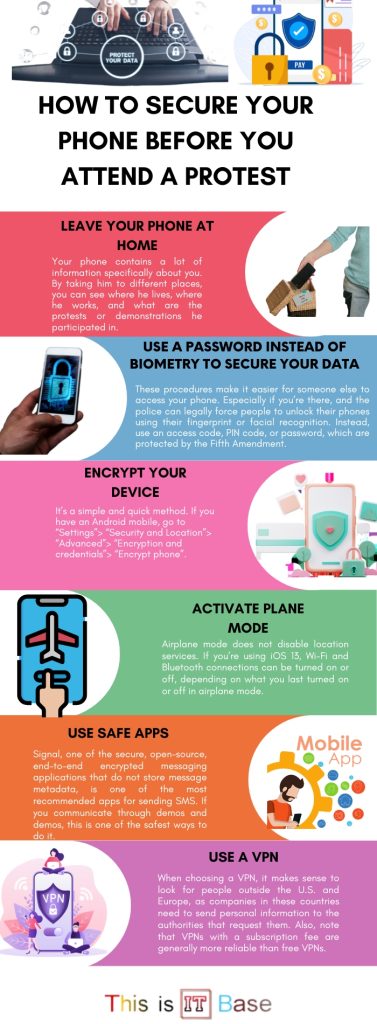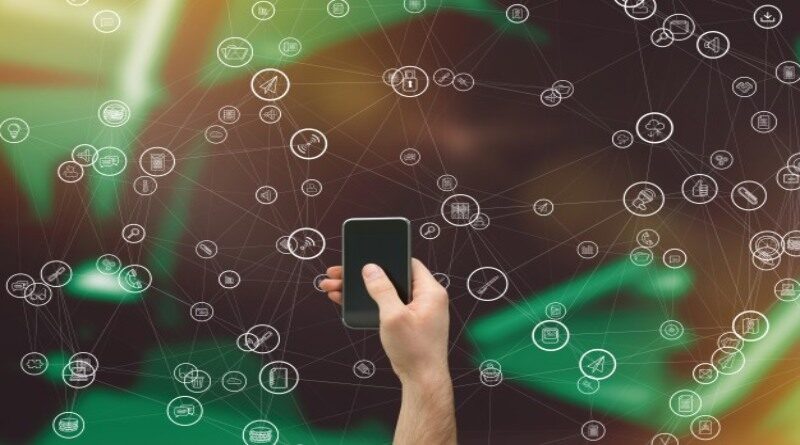How to secure your phone before you attend a protest
Table of Contents
Introduction:
Data secure is an ongoing issue, and we are still learning how to collect and sell information. What types collected, who can access it, and what can learn from it. The following strategies are essential when participating in a protest. However, they are also useful if you want to be careful with the daily use of technology.
Here are some strategies to study.
LEAVE YOUR PHONE AT HOME
Your phone contains a lot of information specifically about you. By taking him to different places, you can see where he lives, where he works, and what are the protests or demonstrations he participated in. Furthermore, each application you use collects a certain amount of information about you and has a detailed record of your activities. For example, if you practice Twitter or Instagram during a protest, this activity and your social media account will be linked to the rally.
Avoid having all this information with you. If you can, buy and use a burner phone and only light it when you are on the demo site. Download more secure encrypted communication apps and use them instead of the standard SMS apps on the phone (we’ll give some examples later).
If you bring your phone, secure your device when removed and delete all personal data from the phone. You can also completely erase your phone (of course, after backing up all data) and add the apps and information you need. Try to keep your phone turned off unless necessary.
USE A PASSWORD INSTEAD OF BIOMETRY TO SECURE YOUR DATA
It is an excellent idea to variation your phone settings so that you cannot unlock it with your pattern before facial appreciation. These procedures make it easier for someone else to access your phone. Especially if you’re there, and the police can legally force people to unlock their phones using their fingerprint or facial recognition. Instead, use an access code, PIN code, or password, which are protected by the Fifth Amendment.
Adjust your settings so that you cannot see the message content in notifications when your phone is locked. During the event, try not to unlock your phone unless it is necessary. If you’re taking photos and videos, try to access your camera without answering your phone. (On an Android phone, this varies conditional on the model, for example on a Pixel, press the Power button twice. On mobiles, you can open the camera from the lock screen by pressing long on the camera icon at the bottom in the right corner or swipe to the side of the lock screen).
Also Read: 6 Signs Your Android Phone Has Hidden Malware
ENCRYPT YOUR DEVICE
It is always an excellent repetition to encrypt your personal information. Still, if your mobile is confiscated, stolen, or lost, you do not want information related to you or others in the protests to falling into your hands—authorities (or any other person). So, if you haven’t done so, now is a good time to protect your device and all the information it contains.
It’s a simple and quick method. If you have an Android mobile, go to “Settings”> “Security and Location”> “Advanced”> “Encryption and credentials”> “Encrypt phone”.
For an iPhone, as long as you have defined an access code and you see the text “Data protection is activated” at the bottom of the “Touch ID & Passcode” page, your information is secure.
ACTIVATE PLANE MODE
Your phone transmits a lot of information about you, including where you are. These signals can not only be intercepted but also used for localization and connection. So when you watch a demo, you want your phone to communicate the least amount of information about you.
Please leave your phone turned off or put it in airplane mode, where mobile data and Wi-Fi disabled by default. This prevents cellular operators from knowing where you have based on the phone towers you connected. It also protects against all sequence attacks, that is when a device imagines being a cell tower and collects information, including location, from nearby phones. The police accused of using manta rays or cell phone simulators to receive information from phones.
Airplane mode does not disable location services. If you’re using iOS 13, Wi-Fi and Bluetooth connections can be turned on or off, depending on what you last turned on or off in airplane mode. Therefore, it is a good idea to make sure that all of these services are disabled. If Airplane mode interferes with your activities, turn off mobile data, Bluetooth, location services, and Wi-Fi individually and only for what you need.
Also Read: How to prevent our social media data from being overshared.
USE A GUIDED ACCESS OR PIN YOUR SCREENS
Android and iOS have features that allow you to access an app while successfully securing the rest of the mobile, so you can use that app while charging the device securely. It’s a safer way to post or take photos on social media during an event. This is useful when you need to see someone on your phone, including law enforcement.
The iOS function is called guided access. To activate it, first, go to “Settings”> “Accessibility”> “Guided access” and enable it. Once activated, additional parameters are displayed, e.g., For example, set the hours of access and lock your screen with an access code.
Open the application you want to use to use the guided access. Press the Home button three times to lock all other apps on your phone. (You may need to click “Start” in the upper right corner to activate the guided access.) To deactivate the guided access, press the Home button three times, enter your access code and press the corner upper left of “The end” shelter.
On Android, the procedure is called screen pinning. Follow the steps, go to “Settings”> “Security”> “Advanced”> “Lock screen” and turn it on. You can configure it to ask for your PIN code before unlocking it. To pin an app, tap the square preview button at the bottom of the screen. Now select the app you want to pin. Lengthy press the app icon at the top of the screen. Now select “Pin”—long-press the Back and Preview buttons to unlock them.
Also Read: Is Appium Better Than Espresso For Android Testing?
USE SAFE APPS
If you use your phone or even a recording phone, use particularly secure applications. The Electronic Frontier Basis has a list of recommended tools for protecting your phone. You can also try one of them.
Signal, one of the secure, open-source, end-to-end encrypted messaging applications that do not store message metadata, is one of the most recommended apps for sending SMS. If you communicate through demos and demos, this is one of the safest ways to do it. For added security, you should also take advantage of some of the more secure features by adjusting your privacy settings. Such as: For example, set a PIN code or use bookmarks. It also has a handy message disappearance feature that makes all messages sent in a conversation disappear after a specified delay.
If you are using an Android portable, you should use a browser that is more secure than Chrome. The most important thing is Tor (Android only). Which protects your identity and information by starting your business through a series of retransmissions. Other security-conscious browsers are Brave (Android and iOS). Which is aggressive against advertisements, and Vivaldi (Android only), which has some tools to improve privacy. If you have an iPhone, Apple controls the security of your Safari browser very strictly (although explosions have occasionally occurred).
Finally, a search engine like DuckDuckGo does not save your search history. Do not link it to your IP address.
USE A VPN
Inside or outside of a demo, it is always a good idea to download and configure a VPN on your phone (our detailed instructions and some recommendations can found here). A VPN hides your motion by encrypting your connection. When choosing a VPN, it makes sense to look for people outside the U.S. and Europe, as companies in these countries need to send personal information to the authorities that request them. Also, note that VPNs with a subscription fee are generally more reliable than free VPNs.
Infographic: How to secure your phone before you attend a protest





